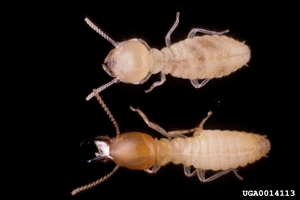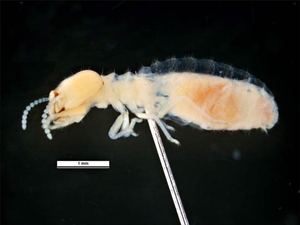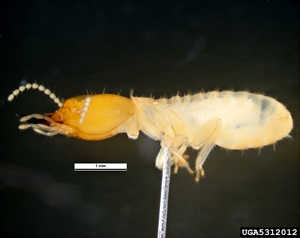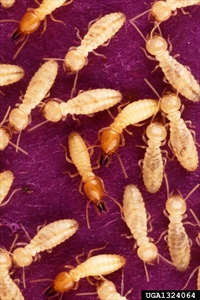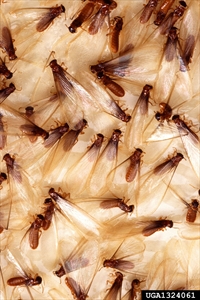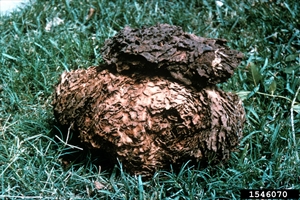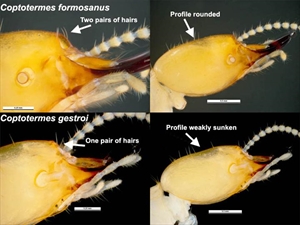Formosan subterranean termite
Pacific Pests, Pathogens and Weeds - Online edition
Pacific Pests, Pathogens & Weeds
Formosan subterranean termite (440)
Coptotermes formosanus. It is also known as Coptotermes intrudens. Coptotermes gestroi is similar (see Fact Sheet no. 384).
Asia, Africa (South Africa), North America (including Hawaii), the Caribbean (US Virgin Islands), Oceania. It is recorded from Marshall Islands.
The heartwood of many living trees are attacked as well as timbers of buildings.
An invasive termite of great importance because of colony size and speed of destruction. A colony may contain several million individuals that forage up to 100 m through soil. Although mostly subterranean, above-ground colonies may exist in buildings, either with no connection to the ground or connected by foraging tunnels, 5-10 mm diameter.
There are three types of termites in the colonies, called castes. (i) 'reproductives' (king, queen, males and females with wings, and nymphs); (ii) soldiers (Photo 1), and (iii) workers (Photos 1-4). The winged males and females (reproductives or 'swarmers') have yellowish-brown bodies, 12-15 mm long, with golden-brown heads (Photo 5). Soldiers (defend the colony) have whitish bodies, 4-5 mm long, with orange-brown oval heads, and curved protruding mouth parts. They can discharge a defensive glue-like fluid from a hole in the head. Workers (collect cellulose from wood, build the nest, feed the larvae) are whitish and similar in length to the soldiers.
The reproductives swarm (they are called 'swarmers') and after a brief flight the females and males look for nesting sites. When a moist crevice is found, 15-30 eggs are laid, hatch after 2-4 weeks, and are cared for by the reproductives. Later, the queens lays more eggs, which are cared for by the first to hatch. The colony grows over 5-7 years before reproductives form and the cycle begins again.
In its natural environment the termite feeds on living and dead trees and wood debris on the soil surface, but it has moved into towns and cities where it feeds on wood used for buildings. Typically, the structures are hollowed-out leaving a paper thin outer 'skin'. There may also be what are called 'carton' (honeycombed) nests made from frass, soil, chewed wood and termite saliva within the wooden structures (Photo 6).
Spread over long distances is mostly associated with shipping and the transport of wooden crates, pallets, rail road sleepers, telephone poles, planting boxes containing soil, anything that contains cellulose and has moisture. Limits to the termite's distribution are 35 degrees north and south of the equator.
This termite is the most important of all termites in terms of costs, and that it is the most difficult to control. In major cities of the US annual damage amounts to many hundreds of millions of dollars. Impacts extend to loss of native diversity (displacement of native termite species, infestation and death of native trees), costs of treating building materials, and the impacts from pesticide use.
Look for the winged males and females reproductives, and the soldiers; these are used for identification. Look for the hairs on the wings of the reproductives.
Look for the following: swarms; mud-covered trails over the ground leading to woodwork; sawdust-like powder near doors and windows; shed wings; and holes and raised paint on wood surfaces. Microscopic examination of the number of fine hairs around the fontanelle (a hole in the front of the head) is necessary to distinguish Coptotermes gestroi (one pair) from Coptotermes formosanus (two pairs) (Photo 7). Also, the hairs on the wings of the reproductives is characteristic. However, because of the similarities between Coptotermes species, samples of the winged form and soldiers should be sent to experts for confirmation.
BIOSECURITY
The termite is on the list of the 100 of the World's Worst Invasive Species compiled by the Global Invasive Species Database, maintained by the IUCN Invasive Species Specialist Group.
Countries still free from the Formosan subterranean termite should take all practical measures to prevent its introduction and further spread. If you suspect a swarm of termites could be a new introduction, contact your biosecurity authority immediately; do not spray with insecticides.
Once established, the termite has never been eradicated from an area.
CULTURAL CONTROL
Where the Formosan subterranean termite has been introduced already there are a number of recommendations to protect homes; these concern drainage, ventilation, treatment of timber.
- Do not remove and transport any wooden materials, plants, furniture, personal effects or soil from any areas declared infested;
- Maintain hygiene and cleanliness around compounds and inside houses. Allow sunshine and free flow of fresh air to move through the buildings. Inspect your homes, trees and compounds thoroughly and regularly;
- Water puddles must be drained away from homes;
- Drainage and piping systems need to be cleaned and maintained; any leaks from pipes, roofs, air conditioners, etc. should be repaired;
CHEMICAL CONTROL
The following methods are used to attempt eradication of termites, or to contain colonies:
- Building codes. Check codes regulating treatment of wood in buildings, especially where wood is in contact with soil. In most cases, preservatives are injected into wood under pressure, using copper compounds, borate, and others. There may be regulations, too, for wooden buildings stipulating the height of floors from ground level; air ventilation for wooden floors in concrete building; height of ceilings; type of framing timbers, and their priming; and which timbers should be painted to prolong its durability.
- Soil treatment: Use insecticides toxic to termites such as synthetic pyrethroids or neonicotinoids as barriers beneath buildings pre-construction or post-construction by drilling and injecting beneath the foundations.
- Baits: Apply chitin synthesis inhibitors to monitoring stations (placed in soil around buildings) when termites are detected or where their presence needs to be monitored. The bait is carried to the colony by foraging individuals. The chemicals in the baits do not kill the termites immediately, but they disrupt moulting. New weather-resistant baits may last 12 months, and initial monitoring is unnecessary. Mostly, these baits with their toxic chemicals are applied by trained pest control operators.
____________________
When using a pesticide, always wear protective clothing and follow the instructions on the product label, such as dosage, timing of application, and pre-harvest interval. Recommendations will vary with the crop and system of cultivation. Expert advice on the most appropriate pesticide to use should always be sought from local agricultural authorities.
AUTHOR Grahame Jackson
Information from CABI (2019) Coptotermes formosanus (Formosan subterranean termite). Crop Protection Compendium. (https://www.cabi.org/cpc/restricted/?target=%2fcpc%2fdatasheet%2f15284); and Su N-Y, Scheffrahn RH (2019) Formosan subterranean termite. Featured Creatures. UF/IFAS. University of Florida. (http://entnemdept.ufl.edu/creatures/urban/termites/formosan_termite.htm); and from Formosan subterranean termite. Wikipedia. (https://en.wikipedia.org/wiki/Formosan_subterranean_termite). Photo 1 Gerald J. Lenhard, Louisiana State University, Bugwood.org. Photos 2&3 Pest and Diseases Image Library, Bugwood.org. Photos 4&5 Scott Bauer, USDA Agricultural Research Service, Bugwood.org. Photo 6 Wood Product Insect Lab USFS, Gulfport, MS, Bugwood.org. Photo 7. Simon Hinkley & Ken Walker Victorian Museum. In: Walker K (2005) Formosan subterranean termite (Coptotermes formosanus). PaDIL - http://www.padil.gov.au.
Produced with support from the Australian Centre for International Agricultural Research under project HORT/2016/185: Responding to emerging pest and disease threats to horticulture in the Pacific islands, implemented by the University of Queensland and the Secretariat of the Pacific.
